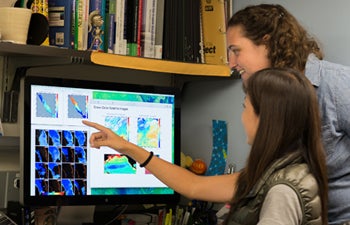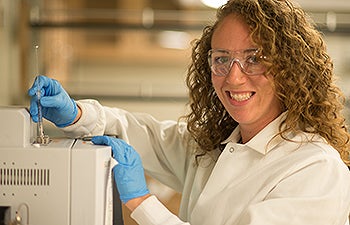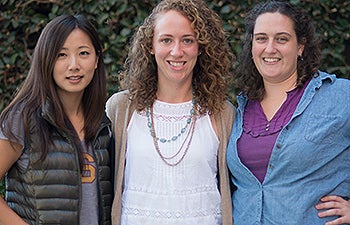Microbes and Climate
A new research laboratory in the USC Dornsife Marine Environmental Biology program is investigating the impact of climate change on microbial communities in the open ocean.
Naomi Levine, Gabilan Assistant Professor of Biological Sciences and Earth Sciences at USC Dornsife, also studies the impact of those microbial communities on global climate and marine ecosystem function.
“The primary focus of my lab is to understand climate-ocean ecosystem interactions and the sensitivity of marine ecosystems to changes in climate,” Levine said. “Currently my lab is focusing on ‘the bottom of the food chain’— the phytoplankton and the bacteria.”
Levine joined USC Dornsife in January 2014 after completing several years of postdoctoral work at Harvard University, part of which was supported by a Climate and Global Change Postdoctoral Fellowship from the National Oceanic and Atmospheric Administration.
During her first year at USC, Levine has developed a research program based in the Allan Hancock Foundation Building with the help of three USC Dornsife graduate students — Xiao Liu, Erin McParland and Elizabeth Teel — and she hopes to expand her lab with postdoctoral positions in the near future. Her position is supported in part by USC Women in Science and Engineering through the Gabilan Assistant Professorship.

Naomi Levine’s graduate students Xiao Liu (sitting) and Elizabeth Teel study computer models of collections of data from the ocean. Photo by Peter Zhaoyu Zhou.
An overarching theme of Levine’s research is the impact of “fine-scale processes” on large-scale dynamics.
The fine-scale processes include the life and death of marine phytoplankton and bacteria; the “large-scale dynamics” include the movement of carbon dioxide, a greenhouse gas, out of the atmosphere and into the ocean surface, where it’s converted into organic matter by microscopic photosynthetic organisms.
If the organic matter sinks to the bottom of the ocean after the organisms die, that carbon might be stored away for thousands of years, but if the organic matter is eaten by bacteria at the surface, the carbon can be released back into the water and ultimately back into the atmosphere.
“We want to know more about the composition of the bacterial community —essentially, who is there and what role the composition of the community plays in large-scale ecosystem dynamics and carbon cycles,” Levine said. “Ultimately, we want to develop a computer model that’s simple enough to run at the global scale and still capture the role that these bacteria are playing.”
Levine stresses the importance of the structure of bacterial communities — what types of bacteria are present, how fast they are growing, and if and how they’re competing with each other.
“We think the rate at which bacteria break down organic matter varies according to what the community looks like,” she said. “The type of compounds they go after might vary with the community structure, and the rate at which they consume nitrogen or release nitrogen. That then impacts photosynthetic organisms.”

USC Dornsife graduate student Erin McParland focuses on chemical oceanography and the effects of climate change on biogeochemical cycles. Photo by Peter Zhaoyu Zhou.
Levine said current computer models of global climate and climate change do not represent dynamic marine bacterial communities and their impact on marine phytoplankton.
“Bacterial community composition is not in the models,” she said, “and yet it can impact the amount of carbon that’s taken up from the atmosphere through photosynthesis, and it also can impact the type of organisms that are doing the photosynthesizing.”
Levine said the composition of these microbial communities is subject itself to the variable nature of the marine environment, including vast eddies that spin off of currents such as the Gulf Stream and tear through their microscopic worlds with the impact of a hurricane.
“You can think about this as ‘weather in the ocean’ and the impact it has on daily life,” she said. “For comparison, if you lived in Miami, where the weather is sunny much of the time but you have periodic torrential downpours, your daily routine would be much different than someone who lives in Seattle, where you have extended periods of constant drizzle all day.
“In the marine environment, we believe we need to understand and model this kind of variability to see how it affects the way marine organisms grow and compete and to accurately predict what will happen to ocean ecosystems in a warmer world.”
Much of Levine’s work involves computer models and “time series” sites where sampling of physical, chemical and biological qualities has been done for decades. One of these is north of Hawaii, the Hawaiian Ocean Time-series (HOT), and one is southeast of Bermuda, the Bermuda Atlantic Time-series (BATS), and sampling has been done at both sites since 1988.

Naomi Levine’s graduate students from left: Xiao Liu, Erin McParland and Elizabeth Teel. Photo by Peter Zhaoyu Zhou.
Another collection of data is from a sampling station in the San Pedro Channel midway between Long Beach and Catalina Island. This is the San Pedro Ocean Time-series (SPOT), a systematic long-term study on the physical and biogeochemical cycles in the San Pedro Basin that was initiated by the USC Wrigley Institute in 1998. The main objective of SPOT is to record, over time, the distribution of temperature, salinity, microbiological and chemical constituents of the seawater column.
“By comparing a coastal site, such as SPOT, with sites like HOT and BATS in the oligotrophic gyres — the so-called ‘deserts of the ocean’— we can learn a lot about how different types of ecosystems will respond to climate change,” Levine said. “This comparison allows us to develop better global models.”
“The SPOT site is a fantastic data set to ask questions about community composition,” she added. “It’s one of the only datasets I know that has that depth of community composition for both the bacteria and phytoplankton.”
Levine is conducting her research on carbon cycling in the open ocean with support from the National Science Foundation. The project will include collaboration with the USC Neighborhood Academic Initiative to develop an ocean sciences module for neighborhood high schools, including a field trip to the Wrigley Marine Science Center and hands-on boat experience collecting oceanographic data, possibly aboard USC’s vessel Miss Christi.
Levine’s three graduate students have support from a NASA Earth and Space Science Fellowship (Xiao Liu), a National Defense Science and Engineering Fellowship (Erin McParland) and a NSF Graduate Research Fellowship (Elizabeth Teel).